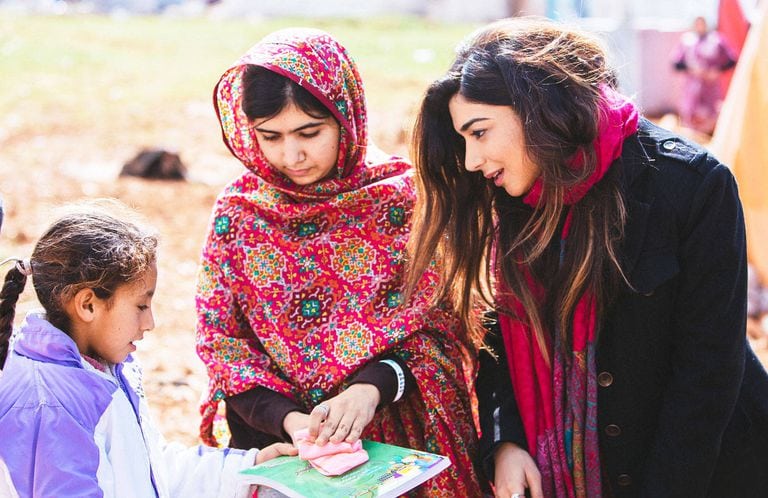
From The Malala Fund To NOW Ventures, Shiza Shahid Wants Companies To Do Good In The World
Lifestyle Jul 09, 2018
Tech entrepreneur, innovator, former co-founder and CEO of The Malala Fund and current founder of NOW Ventures, Shiza Shahid shares her thoughts on the philosophy of a mission-driven business. Shiza Shahid wants companies to do good in the world by implementing corporate social responsibility in their business plans and why it’s a good thing for employers, employees and their related communities.
It all started with a YouTube video of a young female student from Swat Valley who was fighting for her and her fellow female classmates’ right to an education. Across the globe, a Pakistani Stanford University student who was active in her home country’s volunteer space happened to come across that video and decided that she wanted to help. She connected with the father of the newly discovered YouTube activist, who along with his daughter brought a group of students to secret 10-day empowerment camp called Shajar-e-ilm, or Tree of Knowledge two hours away in Islamabad.
Shiza Shahid along with her group of college students established the camp in 2009 in her hometown of Islamabad and among the many students who attended included Malala. It was her father — Ziauddin Yousafzai, also an education activist —with whom Shahid initially connected with to help with camp enrolment.

Did Malala (who was 13 at the time) stand out? Shahid noted that it was not only Malala but the rest of her group who were just as passionate about female empowerment and the right to girl’s education as she was. “I still remember when they spoke” Shahid recalled, “I was just speechless. They were demanding justice for what they had been through.”
As the keynote speaker at the recent Capital One Digital For Good Summit in Toronto, Shahid recalled her journey from providing mentorship resources for Malala and her classmates through her camp, to landing in Birmingham, England (Shahid was working at McKinsey & Company at the time) to be by her 15 year-old friend’s hospital bedside, to ending up being the go-between between Malala and the deluge of global media interested in telling Malala’s story.

The triumvirate of good —Malala, Mr. Yousafzai and Shahid — realized the best way to harness Malala’s growing power was to create a platform geared towards spreading awareness on the importance of a girl’s education as well as providing resources to help others do the same. In 2013, less than a year after the shooting, a non-profit startup known as The Malala Fund was born. Shahid was the CEO and she was just 22 years old.
“Being a young woman at 22 and walking into powerful rooms and holding my own was something that a lot of people in the non-profit space weren’t particularly excited about.” The ageism on younger leaders was prevalent in the non-profit sector and was not lost on Shahid. “Some would say while I was in the room, ‘Your CEO looks so young’ or ‘Sweetheart, how old are you?’” Sure, that sort of reaction would typically light the fire to prove them wrong, but Shahid candidly reflected that, “it also sucked”.



After her time at The Malala Fund, Shahid wanted to take her experience and explore the intersection of startups and philanthropy. As the founder of NOW Ventures , a funding platform, she along with a select group of notable entrepreneurs share the focus to help “mission-driven” companies find a place in the marketplace.
As we started delving into the world of Corporate Social Responsibility (CSR) I felt that it would be prudent to read the rest in her own words.
Hina P. Ansari: Shiza, tell me about NOW Ventures and their mantra about supporting mission-driven startups.
Shiza Shahid: There’s this growing social consciousness and young people are saying, “I don’t want to work for a company that doesn’t make me feel like I’m making a difference.” In an era where talent is the biggest determinant of success, successful companies must become more mission-driven. There’s this intersection, it’s good for business, it’s good for the world, that makes me excited about mission-driven business.
Nine out of ten millennials say businesses should be measured by more than just their financial success. Half of them have ruled out working for an organization because of its values. 96% of consumers say they would switch brands to one that supports a cause.
HPA: Do you find that the awareness is a lot more prevalent now especially with established companies choosing to add a socially relevant angle to their business plan?
SS: Yeah, it’s going to be extremely important and companies are doing it well and they’re doing it badly. I think it was wonderful for me to participate in the Capital One Digital for Good Summit. How they’re using their platform to help non-profits leverage technology more effectively.
The inauthenticity is a huge red flag. I do spend time now, going and speaking at established businesses about how do you go beyond CSR. CSR is important but how do you integrate impact into your business model? Starbucks is interesting. They’ve always been quite forward looking in their impact and they will pay for college, for example, for their employees. They’ve always embraced mission; I think a lot more than most companies.

HPA: Can you give some examples of established companies who have succeeded in their own mission-driven initiatives?
SS: One of my favourite examples is Ben and Jerry’s. Ben and Jerry’s is an ice cream company. Nothing inherently mission-driven about ice cream but they use their supply chain. They source their brownies from a factory in Brooklyn that employs homeless people, those who have criminal records, or formerly incarcerated and those who are struggling with addiction. They source their dairy from sustainable family farms and they’re able to use their supply chain to make a difference all through the magic of ice cream.
HPA: Corporate Social Responsibility (CSR) seems to be an element that companies are starting to incorporate into their overall business structure. Tell me your perspective on ways companies can put this into motion the right way.
SS: In addition to investing in start-ups, I’m spending time now with companies that are curious about how do we think about this and the lenses of your workplace culture. You have a diverse culture and women’s empowerment in your CSR initiative and give loans to women but have no women on your board, right? That just doesn’t vibe.
What are you doing in your product traits? You can’t donate to save the oceans and sell plastic bottles, right? Are you creating materials that are more circular that don’t generate waste? What are you doing for the community in the world? Are you building a factory in a town that’s lost jobs? Are you providing education in a country that are you are outsourcing jobs to? What are you doing that’s greater for the world and for your community?
HPA: When it comes to established businesses, what tips would you give them to make sure they’re on the right track when it comes to CSR?
SS: [First] It has to come from the top. It cannot be a department that is somewhere in the hierarchy that’s coming up with an impassioned plan. You have to have leadership that’s fundamentally mission-driven. Take for example, Marc Benioff the CEO of Salesforce. Someone in his C-suite came to him and said, “We have a pay gap,” and he said, “No way, we’re ranked the best place to work.” She said, “I’m going to request an audit but if we find a pay gap we can’t look away.” He said, “Sure.” They found out that there was a wage gap in every department in every country so he fixed it. The next year, they did an audit again, found that they had the same issue because they’d acquired a bunch of companies. He’s committed to doing this every year and he’s going out and saying, “Look. we were the best place to work and this existed in our company.”
[Second] It’s critical that your leadership be mission-driven, otherwise, it’s just fundamentally inauthentic. I think it’s critical that it be integrated into your business model so it cannot just be the fact that they are just giving away money.
[Third] It has to be something that is linked to your core expertise and something that only you can uniquely do. It has to resonate with your employees and your customers because ultimately, you want this to be something that’s good for the world and good for your business. If your employees are all based in Canada, and your Head of CSR is Chinese and she comes up with a program to build orphanages in China but it’s not something that your customers in Canada or your employees in Canada have a deep sense of connection to, then you’re giving away money, [which is] great but you’re not benefitting from it as a business. Eventually when that employee leaves or that program dries up, it’s over.

HPA: It seems everywhere you turn, there’s a new entrepreneur on the block. What is the allure?
SS: Today 76% of people in high school say they want to be entrepreneurs. Being entrepreneur is the new rock star in a way, but I don’t think that means that they want to start their own company. That’s not even possible for everyone to start their own company or their own non-profit. It’s not efficient. I think what they mean is they want agency and autonomy. They want a sense of ownership and control and meaning and I think they also recognize that there’s no safe careers anymore as every industry is being disrupted.
HPA: Do people have to be on their own to fulfil their need for ownership and autonomy?
SS: With an entrepreneurial spirit, you can be intrapreneurial in an organization. A lot of young people will work in an organization but they will express themselves creatively so they will buy second hand clothes at a thrift shop and create an Instagram following and sell those clothes online and so they have this mini business on the side where they’re able to express themselves.
HPA: People can still make a difference in their everyday lives as well.
SS: You can make a difference every day in how you approach the world. Sometimes, the line between a small difference and a big difference is very unclear. You can mentor a child who holds the cure for cancer and you are the reason that person ever felt that they were worth anything, and that they should actually lean into their passion for studying medicine.
HPA: With social media, there’s this automatic assumption that you have to be visible to be able to make an impact. Is that true?
SS: Visibility is not the same thing as impact. The people that I admire the most, they never gave a TED talk. They never got these awards. They were just doing the work at a grassroots level. Their names will not be known but they will have made a massive difference and they probably will have lived a fulfilling and meaningful life. You can’t plan for fame or fortune when doing this work. You have to set values that are internal that are based on the work itself versus on the number of Instagram likes you get.
HPA: In today’s social justice climate you see examples of students leading the charge for change. Recent examples include the students of Marjorie Douglas Stoneman High School and their passionate activism against gun violence and for sensible gun legislation. And of course, Malala being another obvious example.
SS: A friend of mine runs a petition platform called Change.org. He says there is no force more powerful than a 13-year old girl. When 13-year old girls start petitions, they will take the world by storm.
They show up at council meetings, take the microphone and ask for their questions to be answered. They won’t back down. They don’t have the fear. They feel they’re entitled to an answer whereas as adults, we’re like, “Should I? You might be offended. I don’t know if what I said it was smart.” Girls are like, “Why was there a shooting at my school? Why won’t you regulate guns now?”
Because for a while, I think parents raised a generation that was more apolitical. They’re like, “focus on school, keep your head down, work hard,” but now, I see a wave of growing activism and it makes me hopeful because we need it.
Main Image Photo Credit: www.townandcountrymag.com
Hina P. Ansari
Author
Hina P. Ansari is a graduate from The University of Western Ontario (London, Ontario). Since then she has carved a successful career in Canada's national fashion-publishing world as the Entertainment/Photo Editor at FLARE Magazine, Canada's national fashion magazine. She was the first South Asian in...













































































































